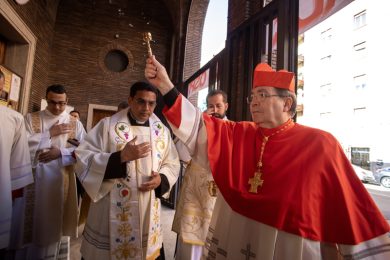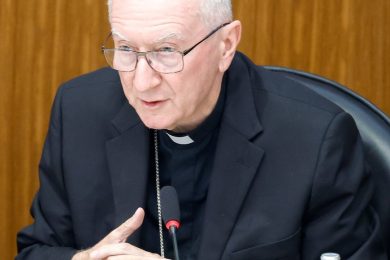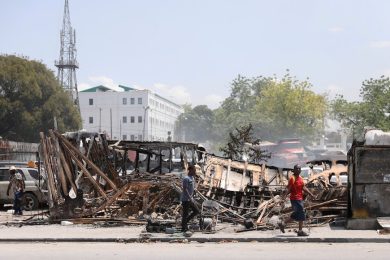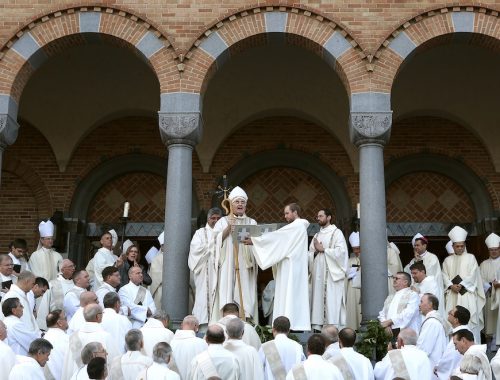SOURCES: United States Conference of Catholic Bishops, Associated Press Stylebook and Catholic News Service Stylebook
1. Need for a new bishop
A diocese is identified as having a need for a new bishop, usually due to to his retirement at the age of 75.
Words to know:
Diocesan bishop: Pastoral and legal head and representative of a diocese
St. Cloud Bishop Donald Kettler submitted his resignation on Nov. 26, 2019, his 75th birthday, as is the norm for bishops. Bishop Kettler will continue in his role until a new bishop is named.[/perfectpullquote]
2. Bishops’ recommendations
Every bishop may submit to the archbishop of his province the names of priests he thinks would make good bishops. Prior to the regular province meeting (usually annually), the archbishop distributes to all the bishops of the province the names and curricula vitae of priests who have been submitted to him. Following a discussion among the bishops at the province meeting, a vote is taken on which names to recommend. The number of names on this provincial list may vary. The vote tally, together with the minutes of the meeting, is then forwarded by the archbishop to the apostolic nuncio in Washington, D.C. The list is also submitted to the U.S. Conference of Catholic Bishops (USCCB).
Words to know:
Province: A territory comprising one archdiocese, called the metropolitan see, and one or more dioceses, called suffragan sees. The Code of Canon Law spells out certain limited obligations and authority that the metropolitan archbishop has with respect to the dioceses within his province. The United States is divided into 33 ecclesiastical provinces.
Curriculum vitae: (Plural: curricula vitae; Latin for ‘course of life’). A summary of one’s personal history and professional qualifications, as that submitted by a job applicant — i.e. a résumé,
Bishops are the successors of the apostles. A bishop can trace this line, called apostolic succession, all the way back to St. Peter, the first bishop.[/perfectpullquote]
3. The apostolic nuncio
By overseeing the final list of names forwarded to Rome, the apostolic nuncio plays a decisive role in the selection process. He not only gathers facts and information about potential candidates, he also interprets that information for the Congregation for Bishops. Great weight is given to the nuncio’s recommendations, but it is important to remember that his “gatekeeper” role does not mean that his recommendations are always followed.
For Diocesan Bishops:
- After receiving the list of candidates forwarded by a province, the apostolic nuncio conducts his own investigation into the suitability of the candidates.
- A report is requested from the current bishop or the administrator of a diocese on the conditions and needs of the diocese. If the appointment is a replacement for a diocesan bishop or archbishop about to retire, consideration will be given to the incumbent’s recommendations. Broad consultation within the diocese is encouraged with regard to the needs of the diocese, but not the names of candidates.
- The report is to include the names of individuals in the diocese with whom the nuncio might consult and how to contact them.
- Previous bishops of the diocese are consulted.
- Bishops of the province are consulted.
- The president and vice president of the USCCB are consulted.
- If the vacancy to be filled is an archdiocese, other archbishops in the United States may be consulted.
- At this point, the nuncio narrows his list, and a questionnaire is sent to 20 or 30 people who know each of the candidates for their input.
- All material is collected and reviewed by the nuncio, and a report (approximately 20 pages) is prepared. Three candidates are listed alphabetically — the “terna” — with the nuncio’s preference noted. All materials are then forwarded to the Congregation for Bishops in Rome.
Words to know:
Apostolic nuncio: The pope’s representative to both the government and to the hierarchy of a given nation; a key person in deciding what names are recommended to the Congregation for Bishops for possible episcopal appointment.
Terna: A list of three candidates for a vacant office, including the office of bishop.
What do you think your first reaction will be when you get the call from the apostolic nuncio?
“A little bit of relief because I’ve been thinking about this so long, and now I’d know for sure. It will also set off in my head questions about what I’m going to do when I’m not an active bishop anymore.” ~ Bishop Kettler [/perfectpullquote]
4. Congregation for Bishops
Once all the documentation from the nuncio is complete and in order, and the prefect of the Congregation approves, the process moves forward. If the appointment involves a bishop who is being promoted or transferred, the matter may be handled by the prefect and the staff. If, however, a priest is appointed to the episcopacy, the full congregation is ordinarily involved.
A cardinal relator is chosen to summarize the documentation and make a report to the full congregation, which generally meets twice a month on Thursdays. After hearing the cardinal relator’s report, the Congregation discusses the appointment and then votes. The Congregation may follow the recommendation of the nuncio, choose another of the candidates on the terna, or even ask that another terna be prepared.
Words to know:
Congregation for Bishops: A department of the Roman Curia, headed by a cardinal. The head of the Congregation, called the “prefect,” is presently Cardinal Marc Ouellet, a Canadian. Among the congregation’s responsibilities are moderating all aspects of episcopal appointments; assisting bishops in the correct exercise of their pastoral functions; handling ad limina visits (regular visits to Rome by bishops every five years); and establishing episcopal conferences and reviewing their decrees as required by canon law. Its membership consists of approximately 35 cardinals and archbishops from around the world.
What quality or qualities do you look for in the priests you recommend to the province for consideration?
“Because I’ve been a parish priest all my life, I want priests who I consider to be good pastors to be considered for the role of bishop. I hope they will be good collaborators – with the priests, their diocesan staff and so on.” ~ Bishop Kettler [/perfectpullquote] [perfectpullquote align=”full” bordertop=”false” cite=”” link=”” color=”” class=”” size=”14″] FUN FACT:
What will you miss most about being the bishop of St. Cloud?
“The people and some of the special liturgies like ordinations and confirmations.” ~ Bishop Kettler [/perfectpullquote]
5. The pope decides
At a private audience with the pope, usually on a Saturday, the prefect of the Congregation for Bishops presents the recommendations of the Congregation to the Holy Father. A few days later, the pope informs the Congregation of his decision. The Congregation then notifies the nuncio, who in turn contacts the candidate and asks if he will accept. If the answer is “yes,” the Vatican is notified and a date is set for the announcement.
It often takes six to eight months — and sometimes longer — from the time a diocese becomes vacant until a new bishop is appointed.
6. What happens once a new bishop is announced?
Typically, the diocese welcoming the new bishop or bishop-elect will hold a press conference and publicize the newly named in various ways through news and social media outlets.
If the newly named is a priest and not yet a bishop, he is then called a bishop-elect. Before assuming his new role, he will be consecrated as a bishop through ordination by at least one other bishop.
If the newly named person is already a bishop, he becomes bishop of the new diocese through canonical profession at a Mass of Installation.
At the ordination/installation, the new bishop will take canonical possession of the diocese and will take his seat in the “cathedra” and be presented with the crosier.
A new bishop or bishop-elect also will design a coat of arms using symbols of his choosing as well as a motto.
Words to know:
Cathedra: The bishop’s chair in a cathedral.
Crosier: Preferred to “crozier” as the spelling for the staff that is one of a bishop’s symbols of office. It may also be called a pastoral staff.
Coat of Arms: A coat of arms is a group of emblems and figures (heraldic bearings) usually arranged on and around a shield and serving as the special insignia of some person, family or institution, in this case, a bishop and the diocese he is serving.
Feature photo by Dianne Towalski






















